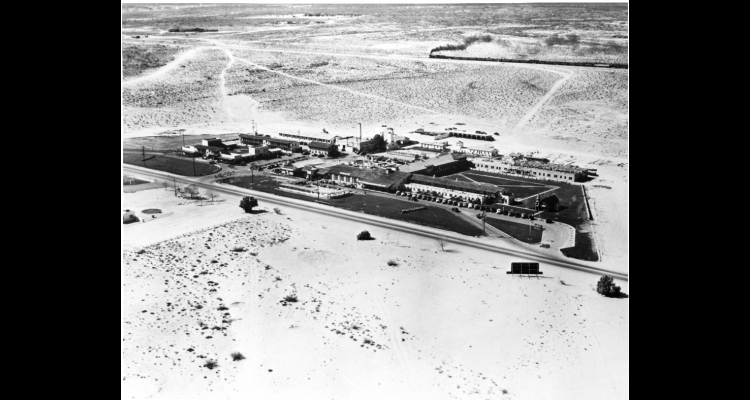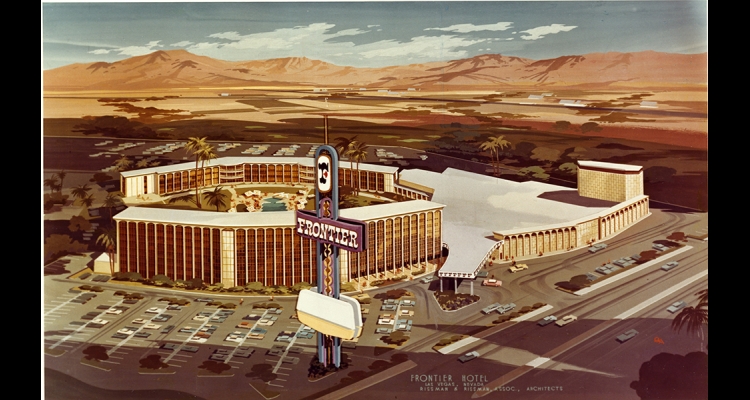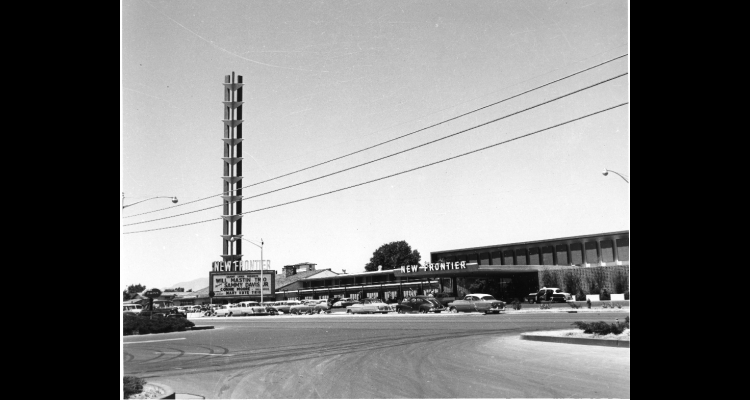Last Frontier Hotel
The Last Frontier Hotel is best known as the second resort built on the fledgling Las Vegas Strip, located along historic Highway 91. Built several miles south of downtown Las Vegas, the Last Frontier was completed in 1942, a year after the debut of its neighbor, the El Rancho Vegas.
Like the El Rancho, the idea to build the Last Frontier came almost by chance. In the summer of 1941, wealthy Texan R.E. Griffith and his nephew, William J. Moore, were on their way to California to purchase materials for a resort they planned to build in Deming, New Mexico. While on Highway 91, they stopped in Las Vegas to inspect the El Rancho and liked the secluded desert location so much, they decided to build a hotel and casino about a mile further south. Griffith and Moore reasoned that motorists traveling north on the highway from California would see their hotel, the Last Frontier, before the El Rancho. Griffith bought thirty-five acres on the highway, including the 91 Club, a nightclub and restaurant owned since 1939 by Guy McAfee, a former Los Angeles police officer.
Despite local skepticism about the remote location of their Last Frontier, Griffith and Moore were determined to out-do the El Rancho as a tourist attraction. They bought high quality furniture and imported authentic Western pioneer saddles, antique guns, and other accessories for the hotel's lobby, bar, and restaurant. They bused in expert stonemasons and members of the Ute Indian tribe from New Mexico to fashion fireplaces and patios from sandstone. The pair also bought the nineteenth century, forty-foot solid mahogany bar that had for decades served as the centerpiece of the old Arizona Club in Block 16 in downtown Las Vegas. Moore, the hotel's architect, later built a small facsimile of a Western pioneer town, called the Last Frontier Village, next to the hotel and decorated it with 900 tons of Old West memorabilia. The village became a top local tourist spot. The Last Frontier also hosted the town's first wedding chapel, the Little Church of the West.
In 1951, Moore sold the Last Frontier to Jake Kozloff and Beldon Katleman. They refurbished the resort and in 1955 reopened it under the name Hotel New Frontier. They soon sold it, and its next owners would include Maury Friedman and T.W. Richardson, and then Hacienda owner Warren "Doc" Bayley. The Banker's Life Insurance Company acquired the property in 1964 after Bayley's death, tore down the original buildings, and began construction on a new 500-room hotel.
Days before it was scheduled to reopen in July 1967, billionaire Howard Hughes bought the New Frontier along with an adjacent casino and nightclub, the Silver Slipper. Hughes renamed his acquisition the Frontier. He added a new tower, bringing the hotel's room total to 1,000. In the 1970s and 1980s, the Frontier served as the Las Vegas venue for the Siegfried & Roy magic act.
Hughes' company, Summa Corporation, sold the Frontier and Silver Slipper in 1988 to Margaret Elardi, the former owner of the Pioneer Club casino in downtown Las Vegas. Elardi demolished the Silver Slipper to make way for a new parking lot. In the 1990s, the Frontier served as the site of a long-running labor dispute between Elardi and the Culinary Union Local 226, which represented 550 hotel workers. In 1997, Elardi sold the resort to Kansas businessman Phil Ruffin, and the strike ended. Ruffin, who changed its name back to the New Frontier, announced in 2005 that he and New York real estate investor Donald Trump would be partners in a sixty-four-floor condominium tower, located in the hotel's west parking lot.
In May, 2007, Ruffin sold the remaining thirty-six acres—including the New Frontier—to the Elad Group, owner of New York's venerable Plaza Hotel. Sixty-five years after it's debut, the New Frontier closed its doors on July 16, 2007. It was imploded on November 13, 2007, to make way for a multi-use complex that will feature the Plaza name.
Article Locations
Related Articles
None at this time.
Further Reading
None at this time.



